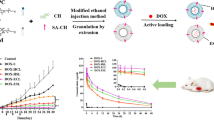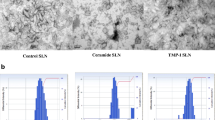Abstract
Purpose
To improve therapeutic activity of mitoxantrone (MTO)-based chemotherapy by reducing toxicity through encapsulation in nanoliposomes and enhancing intracellular drug delivery using short-chain sphingolipid (SCS) mediated tumor cell membrane permeabilization.
Methods
Standard (MTOL) and nanoliposomes enriched with the SCS, C8-Glucosylceramide or C8-Galactosylceramide (SCS-MTOL) were loaded by a transmembrane ammonium sulphate gradient and characterized by DLS and cryo-TEM. Intracellular MTO delivery was measured by flow cytometry and imaged by fluorescence microscopy. In vitro cytotoxicity was studied in breast carcinoma cell lines. Additionally, live cell confocal microscopy addressed the drug delivery mechanism by following the intracellular fate of the nanoliposomes, the SCS and MTO. Intratumoral MTO localization in relation to CD31-positive tumor vessels and CD11b positive cells was studied in an orthotopic MCF-7 breast cancer xenograft.
Results
Stable SCS-MTOL were developed increasing MTO delivery and cytotoxicity to tumor cells compared to standard MTOL. This effect was much less pronounced in normal cells. The drug delivery mechanism involved a transfer of SCS to the cell membrane, independently of drug transfer and not involving nanoliposome internalization. MTO was detected intratumorally upon MTOL and SCS-MTOL treatment, but not after free MTO, suggesting an important improvement in tumor drug delivery by nanoliposomal formulation. Nanoliposomal MTO delivery and cellular uptake was heterogeneous throughout the tumor and clearly correlated with CD31-positive tumor vessels. Yet, MTO uptake by CD11b positive cells in tumor stroma was minor.
Conclusions
Nanoliposomal encapsulation improves intratumoral MTO delivery over free drug. Liposome bilayer-incorporated SCS preferentially permeabilize tumor cell membranes enhancing intracellular MTO delivery.









Similar content being viewed by others
References
Dunn CJ, Goa KL. Mitoxantrone: a review of its pharmacological properties and use in acute nonlymphoblastic leukaemia. Drugs Aging. 1996;9(2):122–47.
White RJ, Durr FE. Development of mitoxantrone. Investig New Drugs. 1985;3(2):85–93.
Koutinos G, Stathopoulos GP, Dontas I, et al. The effect of doxorubicin and its analogue mitoxantrone on cardiac muscle and on serum lipids: an experimental study. Anticancer Res. 2002;22(2A):815–20.
Chungun A, Uchide T, Tsurimaki C, et al. Mechanisms responsible for reduced cardiotoxicity of mitoxantrone compared to doxorubicin examined in isolated guinea-pig heart preparations. J Vet Med Sci. 2008;70:255–64.
Murray TJ. The cardiac effects of mitoxantrone: do the benefits in multiple sclerosis outweigh the risks? Expert Opin Drug Saf. 2006;5(2):265–74.
Cristofanilli M, Holmes F, Esparza L, et al. Phase I/II trial of high dose mitoxantrone in metastatic breast cancer: the M.D. Anderson Cancer Center experience. Breast Cancer Res Treat. 1999;54(3):225–33.
Pusztai L, Holmes FA, Fraschini G, Hortobagyi GN. Phase II study of mitoxantrone by 14-day continuous infusion with granulocyte colony-stimulating factor (GCSF) support in patients with metastatic breast cancer and limited prior therapy. Cancer Chemother Pharmacol. 1999;43(1):86–91.
Cook AM, Chambers EJ, Rees GJG. Comparison of mitozantrone and epirubicin in advanced breast cancer. Clin Oncol. 1996;8:363–6.
Faulds D, Balfour J, Chrisp C, Langtry D. Mitoxantrone. A review of its pharmacodynamic and pharmacokinetic properties, and therapeutic potential in the chemotherapy of cancer. Drugs. 1991;41(3):400–49.
Fox EJ. Mechanism of action of mitoxantrone. Neurology. 2004;63(12 suppl 6):S15–8.
Feofanov A, Sharonov S, Kudelina I, Fleury F, Nabiev I. Localization and molecular interactions of mitoxantrone within living K562 cells as probed by confocal spectral imaging analysis. Biophys J. 1997;73(6):3317–27.
Hajihassan Z, Rabbani-Chadegani A. Studies on the binding affinity of anticancer drug mitoxantrone to chromatin, DNA and histone proteins. J Biomed Sci. 2009;16(31).
van Dalen EC, van der Pal HJH, Bakker PJM, Caron HN, Kremer LCM. Cumulative incidence and risk factors of mitoxantrone-induced cardiotoxicity in children: a systematic review. Eur J Cancer. 2004;40(5):643–52.
Allen TM, Cullis PR. Liposomal drug delivery systems: from concept to clinical applications. Adv Drug Deliv Rev. 2013;65(1):36–48.
Paliwal SR, Paliwal R, Agrawal GP, Vyas SP. Liposomal nanomedicine for breast cancer therapy. Nanomedicine (London). 2011;6(6):1085–100.
Koning GA, Krijger GC. Targeted multifunctional lipid-based nanocarriers for image-guided drug delivery. Anti Cancer Agents Med Chem. 2007;7(4):425–40.
Mattheolabakis G, Rigas B, Constantinides PP. Nanodelivery strategies in cancer chemotherapy: biological rationale and pharmaceutical perspectives. Nanomedicine (London). 2012;7(10):1577–90.
Deshpande PP, Biswas S, Torchilin VP. Current trends in the use of liposomes for tumor targeting. Nanomedicine (London). 2013;8(9):1509–28.
Seynhaeve AL, Dicheva BM, Hoving S, Koning GA, Ten Hagen TL. Intact doxil is taken up intracellularly and released doxorubicin sequesters in the lysosome: evaluated by in vitro/in vivo live cell imaging. J Control Release. 2013;172(1):330–40.
Seynhaeve ALB, Hoving S, Schipper D, et al. Tumor necrosis factor α mediates homogeneous distribution of liposomes in murine melanoma that contributes to a better tumor response. Cancer Res. 2007;67(19):9455–62.
O’Brien MER, Wigler N, Inbar M, et al. Reduced cardiotoxicity and comparable efficacy in a phase III trial of pegylated liposomal doxorubicin HCl (CAELYXâ“¢/Doxil®) versus conventional doxorubicin for first-line treatment of metastatic breast cancer. Ann Oncol. 2004;15(3):440–9.
Laginha KM, Verwoert S, Charrois GJR, Allen TM. Determination of doxorubicin levels in whole tumor and tumor nuclei in murine breast cancer tumors. Clin Cancer Res. 2005;11(19 Pt1):6944–9.
Visani G, Isidori A. Doxorubicin variants for hematological malignancies. Nanomedicine (London). 2011;6(2):303–6.
van Lummel M, van Blitterswijk WJ, Vink SR, 1, et al. Enriching lipid nanovesicles with short-chain glucosylceramide improves doxorubicin delivery and efficacy in solid tumors. FASEB J. 2009;25:280–9.
Veldman RJ, Zerp S, van Blitterswijk WJ, Verheij M. N-hexanoyl-sphingomyelin potentiates in vitro doxorubicin cytotoxicity by enhancing its cellular influx. Br J Cancer. 2004;90(4):917–25.
Veldman RJ, Zerp S, van Blitterswijk WJ, et al. Coformulated N-octanoyl-glucosylceramide improves cellular delivery and cytotoxicity of liposomal doxorubicin. J Pharmacol Exp Ther. 2005;315(2):704–10.
Pedrosa LRC, Hell A, Suss R, et al. Improving intracellular doxorubicin delivery through nanoliposomes equipped with selective tumor cell membrane permeabilizing short-chain sphingolipids. Pharm Res. 2013;30(7):1883–95.
van Hell AJ, Melo MN, van Blitterswijk WJ, et al. Defined lipid analogues induce transient channels to facilitate drug-membrane traversal and circumvent cancer therapy resistance. Sci Rep. 2013;3:1949.
Siskind LJ, Fluss S, Bui M, Colombini M. Sphingosine forms channels in membranes that differ greatly from those formed by ceramide. J Bioenerg Biomembr. 2005;37(4):227–36.
Haran G, Cohen R, Bar LK, Barenholz Y. Transmembrane ammonium sulfate gradients in liposomes produce efficient and stable entrapment of amphipathic weak bases. Biochim Biophys Acta. 1993;1151(2):201–15.
Pinto AC, Moreira JN, Simões S. Liposomal imatinib-mitoxantrone combination: formulation development and therapeutic evaluation in an animal model of prostate cancer. Prostate. 2011;71(1):81–90.
Li C, Cui J, Wang C, et al. Encapsulation of mitoxantrone into pegylated SUVs enhances its antineoplastic efficacy. Eur J Pharm Biopharm. 2008;70(2):657–65.
Lim HJ, Masin D, Madden TD, Bally MB. Influence of drug release characteristics on the therapeutic activity of liposomal mitoxantrone. J Pharmacol Exp Ther. 1997;281(1):566–73.
Rouser G, Fkeischer S, Yamamoto A. Two dimensional thin layer chromatographic separation of polar lipids and determination of phospholipids by phosphorus analysis of spots. Lipids. 1970;5(5):494–6.
Jaffe EA, Nachman RL, Becker CG, Minick CR. Culture of human endothelial cells derived from umbilical veins. Identification by morphologic and immunologic criteria. J Clin Invest. 1973;52(11):2745–56.
Skehan P, Storeng R, Scudiero D, et al. New colorimetric cytotoxicity assay for anticancer-drug screening. J Natl Cancer Inst. 1990;82(13):1107–12.
Li L, ten Hagen TLM, Schipper D, 2, et al. Triggered content release from optimized stealth thermosensitive liposomes using mild hyperthermia. J Control Release. 2010;143:274–9.
Li X, Hirsh DJ, Cabral-Lilly D, 1, et al. Doxorubicin physical state in solution and inside liposomes loaded via a pH gradient. Biochim Biophys Acta. 1998;1415:23–40.
Law SL, Chang P, Lin CH. Characteristics of mitoxantrone loading on liposomes. Int J Pharm. 1991;70:1–7.
Durr FE, Wallace RE, Citarella RV. Molecular and biochemical pharmacology of mitoxantrone. Cancer Treat Rev. 1983;10(Suppl B):3–11.
Orthmann A, Zeisig R, Suss R, et al. Treatment of experimental brain metastasis with MTO-liposomes: impact of fluidity and LRP-targeting on the therapeutic result. Pharm Res. 2012;29(7):1949–59.
Maeda H, Nakamura H, Fang J. The EPR effect for macromolecular drug delivery to solid tumors: improvement of tumor uptake, lowering of systemic toxicity, and distinct tumor imaging in vivo. Adv Drug Deliv Rev. 2013;65(1):71–9.
Yuan F, Leunig M, Huang SK, Berk DA, Papahadjopoulos D, Jain RK. Microvascular permeability and interstitial penetration of sterically stabilized (stealth) liposomes in a human tumor xenograft. Cancer Res. 1994;54(13):3352–6.
Nakasone ES, Askautrud HA, Kees T, et al. Imaging tumor-stroma interactions during chemotherapy reveals contributions of the microenvironment to resistance. Cancer Cell. 2012;21(4):488–503.
Li L, ten Hagen TLM, Schipper D, et al. Improved intratumoral nanoparticle extravasation and penetration by mild hyperthermia. J Control Release. 2013;167(2):130–7.
Storm G, Steerenberg PA, Emmen F, van Borssum WM, Crommelin DJ. Release of doxorubicin from peritoneal macrophages exposed in vivo to doxorubicin-containing liposomes. Biochim Biophys Acta. 1988;965(2–3):136–45.
Mayer LD, Dougherty G, Harasym TO, Bally MB. The role of tumor-associated macrophages in the delivery of liposomal doxorubicin to solid murine fibrosarcoma tumors. J Pharmacol Exp Ther. 1997;80(3):1406–14.
Banciu M, Schiffelers RM, Storm G. Investigation into the role of tumor-associated macrophages in the antitumor activity of doxil. Pharm Res. 2008;25(8):1948–55.
ACKNOWLEDGEMENTS AND DISCLOSURES
This work was financed by the Dutch Cancer Society. The authors thank Thomas Soullié for technical assistance with various aspects of histology and data processing and Sabine Barnert for performing cryo-TEM analyses.
Author information
Authors and Affiliations
Corresponding author
Electronic supplementary material
Below is the link to the electronic supplementary material.
Supplemental Table 1
(DOC 32 kb)
Rights and permissions
About this article
Cite this article
Pedrosa, L.R.C., ten Hagen, T.L.M., Süss, R. et al. Short-Chain Glycoceramides Promote Intracellular Mitoxantrone Delivery from Novel Nanoliposomes into Breast Cancer Cells. Pharm Res 32, 1354–1367 (2015). https://doi.org/10.1007/s11095-014-1539-4
Received:
Accepted:
Published:
Issue Date:
DOI: https://doi.org/10.1007/s11095-014-1539-4




